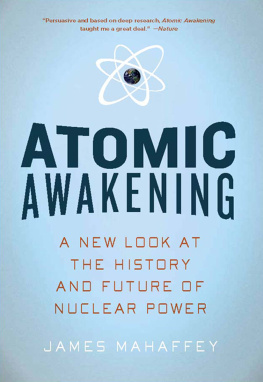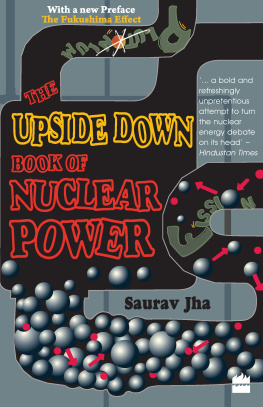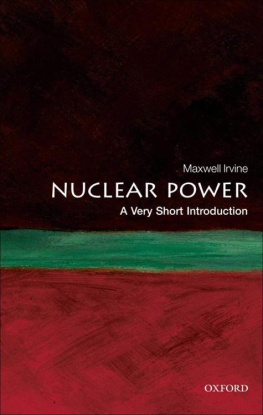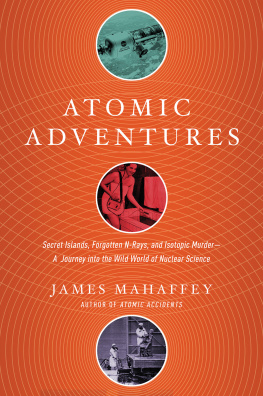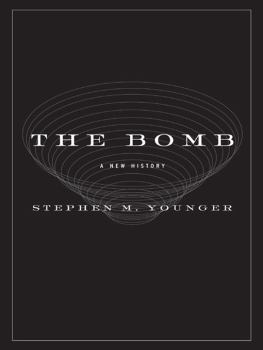Authors Note
An Inside Joke
The word atomic in the title of this book is an antique term that will not go away. It has a certain charm, and its occasional use in discussions of nuclear topics is an echo of an old and largely forgotten bit of literature.
In 1909 Frederick Soddy, a chemist who worked with the great physicist Ernest Rutherford in Canada, published a book detailing recent discoveries in elemental radiation sources, Interpretation of Radium . He and Rutherford had confirmed the existence of energetic rays coming from the recently discovered metal, radium, by a process of the metals disintegration into a lesser element. Marie Curie, who discovered radium, named this new type of energy radiation , and speculation as to its possible application began immediately. Rutherford playfully suggested that if one could find the proper detonator, it might be possible to set off a wave of disintegrations through a solid piece of radioactive metal, which would make this old world vanish in smoke. Soddy agreed, but he was not concerned about it due to the simple logic that this particular advancement was still in the realm of fantasy.
Soddys book was picked up by a famous science fiction writer named H. G. Wells. Wells was by then a well known and successful author, having published The Time Machine in 1895, The Invisible Man in 1897, The War of the Worlds in 1898, and The First Men in the Moon in 1901. He had re-invented the science fiction genre, or at least had given it new life after Jules Verne. Interpretation of Radium gave him an idea for a new novel, and in 1914 he published The World Set Free .
The book was not Wells most popular work, and it can be hard to find, but it may well have been his most important. In The World Set Free Wells predicts a world war in which unusually powerful bombs are dropped. The bombs use radioactive decay as the explosive component, and only one can destroy an entire city. He named these destructive devices atomic bombs.
Technically, Wells description of the technology in these weapons was puzzling at best. He gave the following explanation of the mechanism:
Those used by the Allies were lumps of pure Carolinum, painted on the outside with unoxidized cydonator inducive enclosed hermetically in a case of membranium. A little celluloid stud between the handles by which the bomb was lifted was arranged so as to be easily torn off and admit air to the inducive, which at once became active and set up radio-activity in the outer layer of the Carolinum sphere. This liberated fresh inducive, and in a few minutes the whole bomb was a blazing continual explosive.
Although the scientific descriptions made no sense, the book was popular at least among socially challenged technologists, and it was widely read in the small community of nuclear scientists. Predictions in the book were amazingly accurate, saying that the problem of artificially induced radioactivity would be solved by 1933. Le Szilrd, a brilliant physicist from Hungary, read the book in 1932 and was inspired to think of ways to accomplish the radiation release. In 1933 he solved the problem of self-sustained nuclear fission, and in 1934 he filed a patent for the nuclear reactor.
By World War II the term atomic had vanished over the hill, as the nucleus had been discovered by Rutherford in 1911 and radiation was known to originate in nuclear decay or splitting, and not by any atomic process. Atomic processes, such as chemical reactions, involve the relatively weak electron cloud surrounding the nucleus. It is the powerful nuclear binding forces that proved to be the greater energy source, the source of radiation. In the highly secretive world of nuclear research during the war, descriptive titles or terms were discouraged, and everything had to be given a cute name. The test bomb in New Mexico was called the Gadget . The bomb dropped on Hiroshima was called Little Boy , and the one dropped on Nagasaki was Fat Man . They called the class of nuclear weapons developed during the war the atomic bomb , straight out of H. G. Wells absurd description of his highly destructive device, with a wink. It was an inside joke.
Immediately after the war, the world was informed of the secret nuclear work, and the term atomic bomb from H. G. Wells inspirational novel spilled into the public view. From that point it was hard to stop, and the term became official in 1946, when the Congress of the United States established the Atomic Energy Commission. It was an uncomfortably obsolete name for a serious government agency, and it was finally killed in 1974, when the AEC was replaced by the more dignified-sounding United States Nuclear Regulatory Commission. The term continues on in the names of the Japanese Atomic Energy Commission, the Pakistan Atomic Energy Commission, the Atomic Energy Commission of India, the Commissariat l`nergie Atomique of France, and in an occasional book title.
Introduction
The Paradox Inside a Puzzle Inside a Fantasy
The purpose of this book is not to sell nuclear power. The advantages of nuclear power have been sprayed liberally on the public since before there was any such thing. Some of the first inklings of this new source of energy came in 1939, when the common perception of a looming energy crisis seemed unusually acute. Douglas W. F. Meyer wrote a piece for Discovery magazine, titled Energy from Matter . His article began:
The possibility of making use of the latent energy of the atom is one that has fascinated technicians ever since it was first realized that natural sources of power are limited. Although we are not yet able to say that atomic power is just around the corner, there are indications that a step towards attaining it has been made during the last few months. Already, in New York, atomic power has been used to start chemical reactions, whilst in France, scientists engaged in research on this topic are getting worried at the thought of liberating energy in sufficiently vast and sudden quantities to blow themselves and their apparatus out of existence.
The timing of Meyers article could not have been more relevant.
World War II had begun in Europe only a few weeks after this article appeared, and suddenly talk of latent energy from the atom stopped cold, while military uses were pursued vigorously and a wall of secrecy was erected to cut off any information flow. Six short years later, in August 1945 two atomic bombs were dropped on Japan, and two weeks later an official account of what had transpired behind the wall was published: Atomic Energy for Military Purposes: The Official Report on the Development of the Atomic Bomb under the Auspices of the United States Government, 19401945 , by Henry DeWolf Smyth, the chairman of the Department of Physics at Princeton University. With the publication of this book, the public imagination was re-ignited and the subject of limited natural sources of energy was once more a serious consideration. The battle for hearts and minds began on an industrial scale, as key aspects of the wartime nuclear research were declassified for use in building a civilian-controlled nuclear source for electrical power.

